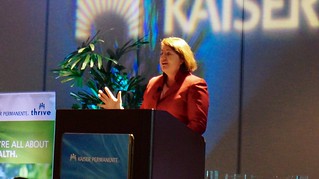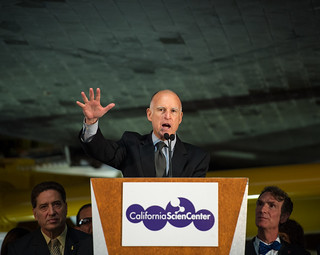I’m brand new to calitics; I joined today at the suggestion of a friend who thought the calitics community might be interested in a piece I wrote about SB 1381, a bill that would require genetically engineered foods in California grocery stores to be labeled. I’ll paste the piece here but you can also check it out at biotechsalon
Rebuttal to Statements Against SB 1381, The California GE Labeling Bill
Posted on April 8, 2014 by Belinda
Senator Noreen Evans (D-Santa Rosa) has introduced a bill, SB 1381, which would require genetically engineered (GE) foods in California’s retail grocery stores to be labeled starting in 2016. I’m in favor of this bill because, as stated in its text, “California consumers have the right to know, through labeling, whether the foods they purchase were produced with genetic engineering, so they can make informed purchasing decisions.” Consumers in 64 other countries can already make such informed purchasing decisions; the food industries in those countries (and in the U.S. when preparing foods for export) already handle the logistics required to label GE foods; doing the same for foods sold in the good ‘ole U. S. of A. should be a slam dunk.
But proponents of GE foods are still fighting against labeling anyway.
Statements made against SB 1381 prior to the bill being approved by the Health Committee of the California State Senate late last month amounted to a defense of genetic engineering technology comprised of definitive-sounding claims of “overwhelming scientific evidence” that GE food products “are completely safe” and mention of multiple, highly regarded scientific organizations “none of which have found any evidence” of problems with these foods [emphases added]. A plant scientist at UC Davis also said claims that the United States Food and Drug Administration (FDA) “does not properly regulate” GE foods are “not true” and that these foods are “fully vetted.”
But, as I’ve been pointing out on this blog, the state of the science and regulation of GE agricultural products is not nearly as black and white as these statements made in opposition to SB 1381 indicate. And for anyone to make truly informed decisions-about GE food purchases or GE labeling or anything else-mention should be made of the shades of grey.
For example, as mentioned in the text of SB 1381, the FDA “does not require safety studies of GE foods. Instead, any consultations are voluntary….” While every GE food on the market today may have gone through this voluntary consultation process with FDA, that need not necessarily be the case for future GE foods and feeds. There have already been cases in which developers of GE crops have refused to provide answers to additional questions asked by FDA; there was also the case of Bt10, a GE corn variety that was accidentally commercialized without having gone through the voluntary consultation process with FDA.
The current system of regulating GE crops and foods in the U.S. uses agencies and laws designed with “traditional” agricultural products in mind; loopholes exist in it through which some GE crops could escape regulation altogether. While others (obviously) disagree, I do not consider the current system in the U.S. to be the “proper” way to regulate the powerful technology of genetic engineering.
As also mentioned in SB 1381:
“Genetic engineering of plants and animals can cause unintended consequences. It has been demonstrated that manipulating genes through genetic engineering and inserting them into organisms is an imprecise process. The results are not always predictable or controllable. United States government scientists have stated that the artificial insertion of genetic material into plants via genetic engineering can increase the levels of known toxicants or allergens in foods and create new toxicants or allergens with consequent health concerns.”
These statements are all true. And in the less than 20 years since GE crops have been commercialized, we’ve already had examples which raised heath concerns. One was StarLink™ corn. Although it has never been established that the Bt protein in StarLink corn-which behaved like a human allergen in multiple pre-market tests-actually caused allergies in humans, the U.S. corn crop was nevertheless monitored for the presence of StarLink’s GE protein for seven years after it was discovered in human food products and taken off the market. (The StarLink incident also gives an idea of how long GE crops can persist in the environment.) Even with no concrete evidence of harm, regulators did not deal with that particular GE corn product as if it was “completely safe.”
Such is the concern over unintended consequences that a “Committee on Identifying and Assessing Unintended Effects of Genetically Engineered Foods on Human Health” was established by the Institute of Medicine and the National Research Council of the U.S. National Academies. The committee’s report promotes “postmarketing studies to further assess both intended and unintended effects” and suggests that “epidemiological studies may be helpful in the postmarketing phase….”
SB 1381 also notes that “mandatory identification of foods produced with genetic engineering can provide a method for detecting, at a large epidemiological scale, the potential health effects of consuming those foods.”
Yet an opponent of SB 1381 stated (in the Health Committee meeting on March 26th) that epidemiological studies would not be helped by “general” labeling of GE ingredients.
I am not an epidemiologist and so will not comment on that claim except to opine that even general labels should make the task of tracking down unintended health effects somewhat easier than no GE labels at all. (I invite any epidemiologists reading this to chime in on this topic.) Instead I’ll ask: what is the alternative? Identifying the specific GE protein or other active GE component that has been added to a food, as was done for the protein conferring kanamycin-resistance in the Flavr Savr™ tomato nearly 20 years ago?
That is apparently no longer a viable option at this juncture. After the FDA treated the GE protein in Flavr Savr tomatoes as a food additive, following the laws on the books for regulating food additives, the agency announced that no other GE protein added to a food need go through that process. The food additive door was shut and replaced with the voluntary consultation process.
The bottom line is that the federal government has let Americans down on this issue. That’s why grass roots initiatives and individual state legislatures are taking it up.
Unintended consequences can, and have, happened as a result of using genetic engineering technology to alter crop plants. Until very recently, there had been no long-term studies of individual GE foods and those that have been published have been attacked…and yet not repeated, the usual hallmark of scientific response to technical disagreement. As a scientist, I find that very disappointing.
And yet I am a supporter of the use of genetic engineering for basic science. I was also an early adopter of GE foods, feeding GE Flavr Savr tomatoes to my child back when they first hit the market in 1994; I and other early adopters purchased so many of those tomatoes, despite (because of?) the fact that they were clearly labeled as having been “Grown From Genetically Modified Seeds,” that the company producing them couldn’t keep up with demand.
Based on the Flavr Savr tomato, the only example we have in the U.S. of a labeled GE food, the labels SB 1381 would require will not necessarily “stigmatize” GE foods. Nor is SB 1381 about forgoing the powerful technology of genetic engineering; agricultural problems like citrus greening are still being addressed using genetic engineering despite concerns about the public’s wariness.
What SB 1381 addresses is the downright un-American status quo that denies American citizens the choice to decide for themselves whether to adopt a powerful new technology being applied to their food. That’s it.
In poll after poll, the majority of Americans indicate they want that choice, a choice citizens of 64 other countries already have.
Kudos to Senator Evans for introducing SB 1381 so that Californians might, after the nearly two decades since the GE Flavr Savr tomato was first introduced into commerce, again have that choice.





